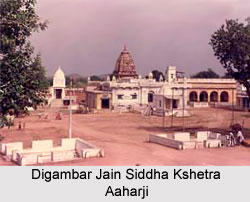 Digambar Jain Siddha Kshetra Aharji is a Jain pilgrimage centre. It is located in the village of Baldevgarh in the Tikamgarh District in Madhya Pradesh. It is a Siddha Kshetra i.e. a place of salvation. The presiding deity of the temple is Lord Shantinath.
Digambar Jain Siddha Kshetra Aharji is a Jain pilgrimage centre. It is located in the village of Baldevgarh in the Tikamgarh District in Madhya Pradesh. It is a Siddha Kshetra i.e. a place of salvation. The presiding deity of the temple is Lord Shantinath.
History of Digambar Jain Siddha Kshetra Aharji
Digambar Jain Siddha Kshetra Aharji dates back to the ancient period. This sacred place is important for its historical and archaeological aspects. Excavations from underneath the earth have lead to the discovery of many broken Jain idols and Jain temples here. It is eminent from the petrography that once there were many high Jain temples made of stones. Inscription on rocks of V.S. 1100 to 1500 have lead to the fact that during the time of king Madanvarmdeo, the old name of this place was Madansagarpur. A pond named Madansagar still exists here. During the period of Lord Mallinath the 19th Tirthankara, the 17th Kamdeo Shri Madan Kumar attained salvation here. Next during the period of Lord Mahavira, Shri Bishkambal attained salvation here.
Digambar Jain Siddha Kshetra is associated with many legends and miracles. It is said that a famous businessman, Panashah had found his tin metal being converted to silver. The place where Panashah stayed still can be seen today and is known as `Tanda Ka Khandha`. According to another legend an ascetic saint got Ahar or meal here after fasting for one month. Hence this place has been named as Aharji.
Temple of Digambar Jain Siddha Kshetra Aharji
The temple of Digambar Jain Siddha Kshetra Aharji is very ancient. The main temple here is Shri 1008 Shantinath Temple that is dedicated to Lord Shantinath, the sixteenth Jain Tirthankara. The idol is 18 feet height and is flaunted by two standing idols of Lord Kunthunath and Lord Arahnath on its either sides. The idols are magnificently carved with intricate designs. Around the main temple one can also see `Tribal Choubeesee,` the 24 Jain Tirthankaras each for three eras the Present, Past and Future. The construction of the main temple was completed in 12th century and idol of main deity Lord Shantinath was installed in V.S. 1237. Thousands of devotees throng the temple to offer prayers to the Lord and receives blessings.
Apart from this, there are many other temples located here. There are seven temples that houses 97 idols dated from V.S. 1109 to 2055. The feet images are also installed here. The other temples located here are Lord Vardhaman Jain Temple and Lord Chandraprabha Jain Temple, Lord Parsvanatha Jain Temple, Lord Mahavira Jain Temple, Bahubali Jain Temple and Panch Pahari (Kailash, Sammed Shikharji, Girnarji, Pawapuri, Champapuri). Two `Manashtanbha` also known as Column of dignity have been constructed in front of Bahubali Jain Temple. It was built in V.S. 1011. Almost a kilometre from the Kshetra, Nirvana Kshetra or place of salvation is located on the top of a hill. A small pond named Madan Talab, a tank of water Madanber, Siddhon Ki Pahari (A Hill), Siddhon Ki Gufa (A Cave) can also be seen here.
Other than these Shri Vardhaman Mandir, Shri Bheru Mandir, Shri Chandraprabha Mandir, Shri Parsvanatha Mandir, Shri Mahavira Mandir, Two columns of dignity in front of Bahubali Mandir (installed in V.S. 1011), Bahubali Mandir and Panch Pahari Mandir are also viewable. The temple organises an annual gathering for five days that hosts many religious and cultural functions. The temple has provisions for dharmashalas or rest houses for the pilgrims. Devotees visiting the temple also enjoy the scenic beauty of the place. The temple is situated in the midst of beautiful forest surrounded by the hills.
Digambar Jain Siddha Kshetra Aharji can be reached via road. Aharji stands on the road from Tikamgarh to Chhatarpur. Busses are available on every hour. The nearest railway station is Railway Station is Lalitpur located at 83 km.




















